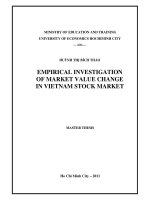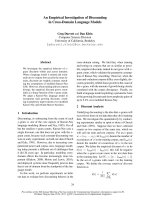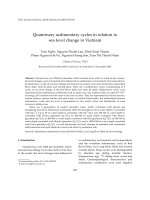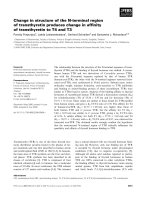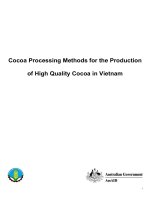Empirical investigation of market value change in vietnam stock market
Bạn đang xem bản rút gọn của tài liệu. Xem và tải ngay bản đầy đủ của tài liệu tại đây (581.94 KB, 100 trang )
MINISTRY OF EDUCATION AND TRAINING
UNIVERSITY OF ECONOMICS HOCHIMINH CITY
--- oOo ---
HUỲNH THỊ BÍCH THẢO
EMPIRICAL INVESTIGATION
OF MARKET VALUE CHANGE
IN VIETNAM STOCK MARKET
MASTER THESIS
Ho Chi Minh City – 2011
MINISTRY OF EDUCATION AND TRAINING
UNIVERSITY OF ECONOMICS HOCHIMINH CITY
--- oOo ---
HUỲNH THỊ BÍCH THẢO
EMPIRICAL INVESTIGATION
OF MARKET VALUE CHANGE
IN VIETNAM STOCK MARKET
MAJOR: FINANCE - BANKING
MAJOR CODE: 60.31.12
MASTER THESIS
SUPERVISOR: Assoc. Prof, Ph.D. TRAN HUY HOANG
Ho Chi Minh City – 2011
ACKNOWLEDGEMENT
I am grateful to my master thesis supervisor, Assoc. Prof, Ph.D. Tran Huy Hoang,
for his guidance, time and insightful comments on my work. It is my honor indeed
to have the opportunity to work with him and I appreciate on the things we have
shared during this time.
I would like to express profound gratitude to Dr. Vo Xuan Vinh for his invaluable
supports and useful suggestions as well as his excellent advising from the very first
to the final steps of mine in conducting the work leading to this thesis.
I would like to express my sincere gratitude to all of my lecturers for their teaching
and guidance during my maser course at the University of Economics, Ho Chi Minh
City.
Finally, the people I would like to thank the most are my parents and my fiancé.
Without their continual encouragement and understanding, I would not have been
able to complete this journey. In addition to immediate family members, there are
many closed friends who have supported me through this rough journey. I feel very
fortunate to have such wonderful friends and supporters in my life.
With my appreciation
Huynh Thi Bich Thao
i
ABSTRACT
This paper attempts to determine stock price volatility in Vietnam stock market
using a rich and detailed data set, including both market data and firm attributes. In
particular, we aim to investigate which firm characteristics affect stock price
volatility. From the perspective of informational asymmetry, the paper examines the
relationship between stock price volatility and firm characteristics of Vietnamese
listed firms on Ho Chi Minh City Stock Exchange. A sample of 110 listed
companies in Vietnam stock market is examined for a period from 2007 to 2009.
The empirical estimation is based on panel data modeling technique. The findings
of the paper indicate that stock price volatility is positively affected by dividend
yield, firm age and liquidity. Meanwhile, it is negatively correlated with firm size.
In addition, the results of this study also report that stock price volatility favors
foods and beverages, industrials and real estates, construction & materials
industries.
Keywords: Stock price volatility, firm attributes, Vietnam stock market, panel data.
ii
CONTENTS
ACKNOWLEDGEMENT...................................................................................... i
ABSTRACT........................................................................................................... ii
CONTENTS.......................................................................................................... iii
LIST OF ABBREVIATION.................................................................................. v
LIST OF TABLES................................................................................................ vi
1
2
3
INTRODUCTION.......................................................................................... 1
1.1
Background, research motivation and rationale .........................................1
1.2
Research objectives and research questions...............................................2
1.3
Methodology.............................................................................................3
1.4
Contribution ..............................................................................................3
1.5
Structure of the thesis................................................................................4
LITERATURE REVIEW .............................................................................. 5
2.1
Stock price volatility and dividend policy..................................................6
2.2
Stock price volatility and firm age.............................................................8
2.3
Sstock price volatility and trading liquidity ...............................................8
2.4
Other firm attributes and stock price volatility...........................................9
DATA DESCRIPTION AND DEVELOPING EMPIRICAL RESEARCH
HYPOTHESES.................................................................................................... 11
4
3.1
Data description ......................................................................................11
3.2
Developing empirical research hypotheses ..............................................20
METHODOLOGY....................................................................................... 25
4.1
Descriptive statistics and correlation matrix ............................................25
4.2
Bivariate analysis ....................................................................................25
4.3
Multivariate analysis ...............................................................................26
4.3.1
Ordinary Least Square (OLS) regression..........................................27
4.3.2
Fixed effects regression....................................................................28
4.3.3
Random effect regression.................................................................29
4.3.4
F-statistic test...................................................................................29
iii
4.3.5
5
Hausman test....................................................................................29
RESULTS AND DISCUSSION OF RESULTS .......................................... 31
5.1
Correlation matrix ...................................................................................31
5.2
Bivariate analysis ....................................................................................33
5.3
Multivariate analysis ...............................................................................35
5.2.1
Overall regression results .................................................................35
5.2.2
Overall regression with industry dummies .......................................39
5.2.3
Regression results in each year.........................................................42
5.2.3.1 Regression results of 2007............................................................42
5.2.3.2 Regression results of 2008............................................................43
5.2.3.3 Regression results of 2009............................................................44
5.2.4
Regression results for each industry .................................................45
5.2.4.1 Basic materials industry ...............................................................45
5.2.4.2 Consumer goods and services industry .........................................46
5.2.4.3 Food and beverage industry .........................................................47
5.2.4.4 Industrials industry.......................................................................48
5.2.4.5 Real estate, construction & materials industry .............................49
5.2.4.6 Others industry.............................................................................50
6
CONCLUSIONS .......................................................................................... 54
6.1
Reviews of findings.................................................................................54
6.2
Contribution ............................................................................................55
6.3
Limitations and recommendations for future researches ..........................55
REFERENCES .................................................................................................... 57
APPENDICES ..................................................................................................... 60
Appendix A: Regression results .........................................................................60
Appendix B: List of 110 companies ...................................................................88
iv
LIST OF ABBREVIATION
HOSE
Ho Chi Minh City Stock Exchange
HNX
Hanoi Stock Exchange
PV
Price volatility
EV
Earning volatility
ROA
Return on assets
ROE
Return on equity
ASGR
Asset growth rate
LEVR
Firm leverage
CURR
Current ratio
DY
Dividend yield
POR
Payout ratio
SIZE
Firm size
AGE
Firm age
TOVR
Liquidity
EBIT
Earning Before Interest and Tax
IPO
Initial Public Offer
OLS
Ordinary Least Square
v
LIST OF TABLES
Table 3.1 Summary of industry structure ...............................................................14
Table 3.2 Description of stock price volatility in Vietnam .....................................15
Table 3.3 Data descriptive statistics for firm attributes ..........................................16
Table 3.4 Data descriptive statistics for firm attributes by year ..............................17
Table 3.5 Data descriptive statistics for firm attributes by industry........................18
Table 3.6 Data description and expected relation to stock price volatility ..............24
Table 5.1 Correlation matrix among variables .......................................................32
Table 5.2 Variance Inflation Factor .......................................................................33
Table 5.3 Bivariate regression results ....................................................................34
Table 5.4 Overall regression results.......................................................................36
Table 5.5 OLS, fixed effect and random effect tests ..............................................39
Table 5.6 Overall regression results with industry dummies ..................................41
Table 5.7 Regression results of 2007 without and with industry dummies .............42
Table 5.8 Regression results of 2008 without and with industry dummies .............43
Table 5.9 Regression results of 2009 without and with industry dummies .............44
Table 5.10 Regression results for basic materials industry .....................................45
Table 5.11 Regression results for consumer goods and services industry...............46
Table 5.12 Regression results of food and beverage industry.................................47
Table 5.13 Regression results of industrials ...........................................................48
Table 5.14 Regression results of real estates, construction & materials industry ....49
Table 5.15 Regression results of others industry ....................................................50
Table 5.16 OLS Regression results with ROA, ROE and EV.................................52
Table 5.17 Cross-section fixed effect regression results with ROA, ROE and EV .53
vi
Empirical investigation of stock price volatility in Vietnam stock market
1 INTRODUCTION
This section starts with reviewing background and figuring out motivation and
rationale of this research. This section is then followed by discussing research
objectives and research questions. After that, a brief of methodology, contribution
and structure of this study is presented.
1.1 Background, research motivation and rationale
Stock price volatility and its determinants remain a source of controversy despite
years of theoretical and empirical research. Investigations of share price changes
appear to yield evidence that changes in fundamental variables should jointly bring
about changes in share prices both in developed and emerging markets. However,
the actual fundamental factors found to be relevant may vary from market to
market. It is widely agreed that a set of fundamental variables as suggested by
individual theories is no doubt relevant as possible factors affecting share price
changes in the short and the long-run.
A substantial a mount of research has been directed toward analyzing the
relationship between stock price volatility and firm attributes. Among those
substantial research in developed market, it can be listed out some outstanding
findings such as Baskin (1989) and Fama and French (1992) in the United States
context and Allen and Rachim (1996) in Australian context. While Baskin (1989)
reports a strongly significant relationship between dividend yield and stock price
volatility, Allen and Rachim (1996) cannot find any evidence to support this
hypothesis but finds another interesting results related to payout ratio.
Even though Vietnam initiates the stock market later than many other developed
countries, there has been a substantial growth. The first stock exchange in Ho Chi
Minh city was established in 2000 with four listed companies. Increased foreign
interest and the privatization of state-owned enterprises lead to a rapid increase in
listings. At the end of 2009, there are about 250 firms listed on the Ho Chi Minh
Stock Exchange and the smaller exchange in Hanoi.
Huynh Thi Bich Thao
1
Empirical investigation of stock price volatility in Vietnam stock market
Most of the previous studies on determinants of stock return volatility focus on
well-developed markets with less attention given to the developing markets. To the
best of the author knowledge, there are very few studies that address the issue of
stock price volatility and fundamental factors in the Vietnamese context. This
motivates the present study to examine whether firm characteristics can affect the
stock price volatility of the Vietnamese companies. This study focuses on the same
issue for Vietnam Stock market, a developing market. Apart from using the latest
data, we develop this study by incorporating selected variables for selected purposes
to examine the determinants of stock price volatility. In addition, industry effects
are also taken into consideration of this research.
As general thinking, the stock prices response to market news everyday. Therefore,
many researches are conducted on investigation over a short horizon with event
study on information announcement effects. By contrast, this study attempts to
examine the relationship between stock price volatility and firm attributes in a long
run basis. In order to facility our primary aim, the stock price volatility is calculated
using Parkinson (1980) method which reduces the mismatch between relevant time
for the share prices and the fundamental ratios. Under this method, this study in
ideal situation should employ quarterly data for analysis. However, there is a large
difference between the internal financial statements of firms and the audited reports.
In addition, according to the regulation, only annual audited reports are required to
submit. This study, therefore, use annual data from audited reports for more
accurate firm attributes.
1.2 Research objectives and research questions
This study is conducted to analyze the behavior of stock price from a broad
perspective. The main purpose of this paper is to determine the relationship between
stock price volatility and firm attributes. We also look at the influence of industry
effect on stock price volatility. In addition, stock price behavior in each year and
each industry is also discussed in this study in order to identify whether there is any
Huynh Thi Bich Thao
2
Empirical investigation of stock price volatility in Vietnam stock market
difference in stock price movement from one year to another year, from one
industry to another industry.
In other words, this research will provide answers to the following questions:
1. Which firm attributes affect firm stock price volatility in Vietnam stock
market?
2. Do firms in different specific industries have different behaviors in stock
price?
1.3 Methodology
Our study engages in the analysis of a panel of 110 companies listed on Ho Chi
Minh City Stock Exchange between 2007 and 2009.
Our empirical analysis is conducted as follows.
-
Descriptive statistics.
-
Correlations matrix between the dependent and independent variables.
-
Bivariate analysis involving regressing the dependent variable PV against
each independent variable separately.
-
Multivariate analysis including ordinary least square regression, fixed effect
regression and random effect regression.
We also take into accounts some robustness test to validate our results.
Eviews software version 6 is used as a data analysis tool to implement this research.
1.4 Contribution
This study applies new method which implements econometric testing and
econometric package to test for empirical results. Firstly, to the best of the author
knowledge, this paper is the very first research carefully investigating the
characteristics of stock price volatility in Vietnam stock market. Our main
contribution to the financial literature is to provide an extensive empirical analysis
on the stock price movements and firm attributes relation over an extended time
Huynh Thi Bich Thao
3
Empirical investigation of stock price volatility in Vietnam stock market
period. The construction of stock price data, together with detailed attributes of
listed firms in Ho Chi Minh City Stock Exchange, allows us to achieve this task. In
addition, this study also takes into account industry effect by allowing industry
dummies in order to consider whether stock price volatility favors a specific
industry in Vietnam stock market.
Secondly, this research provides a useful caution for the investors in terms of real
relationship between stock price volatility and firms attributes.
Last but not least, the limitation of data constraints in this study may offer signals
for policy makers to more strictly regulate on accounting standards and publication
rules.
1.5 Structure of the thesis
This thesis does not follow conventional method which divides into chapters. We
consider each chapter covers a separate matter so that we structure the thesis into
parts which is a better representation.
Our paper is divided into 6 main sections. Section1 briefly introduces major
concerns of this thesis. Section 2 presents theoretical aspects of stock price
volatility focusing on impacts from fundamental factors. Section 3 introduces data
description and hypothesis development. Section 4 describes methodology. The
results of the empirical analysis and their discussions are then presented in Section
5. Finally, Section 6 draws the conclusions of our study, follows by discussions on
the contributions, limitations, and implications for future research.
The structure and methodology of this thesis are guided by Brooks (2008) with
econometric approach to an empirical investigation.
Huynh Thi Bich Thao
4
Empirical investigation of stock price volatility in Vietnam stock market
2 LITERATURE REVIEW
This section provides the necessary theoretical background for the models to be
developed in the next part. In this section, we reviews the literature related to stock
price volatility. In the limited scope of this study, the majority of this section is
focused on reviewing fundamental analyses of stock price volatility which study
relationship between stock price movement and firm attributes in the long run. For
information purpose, reviews of value relevance study for short term relationship
between stock price behaviors with event announcements are also briefed in this
section. In addition, since most of previous studies execute investigation on
relationship between stock price volatility and dividend policy with adding other
factors as controlling variables, this section first reviews those literature strands and
summarizes key fundamental factors in the later part.
Share prices are the most important indicators readily available to the investors for
their decision to invest or not in a particular share. Factors affecting stock prices are
studied from different points of view. Several researchers examine the relationship
between stock prices and selected factors which could be either internal or external.
Theories suggest that share price changes are associated with changes in
fundamental variables which are relevant for share valuation such as payout ratio,
dividend yield, capital structure, earnings, size of the firm and its growth
(Rappoport, 1986, Downs, 1991).
Ball and Brown (1968) are the first to highlight the relationship between stock
prices and information disclosed in the financial statements. Empirical research on
the value relevance has its roots in the theoretical framework on equity valuation
models. Ohlson (1995) depicts in his work that the value of a firm can be expressed
as a linear function of book value, earnings and other value relevant information.
The link between fundamental factors and share price changes is extensively
investigated over short horizons but only few studies attempt to model it over
lengthy periods of time. Studies over short windows commonly apply cross-
Huynh Thi Bich Thao
5
Empirical investigation of stock price volatility in Vietnam stock market
sectional tests using event-based research methodology. The cases of studies
examining this relation cross-sectional or inter-temporally are few, and these have
one common feature i.e., the fundamental factors used in a specific study are either
one or two although there is a long list of fundamental factors. Furthermore, while
price revisions at the time of announcements of price relevant disclosures are valid
as announcement effects shown over short horizons, it is equally important to test
the effect over a lengthier period of time using data over several years as measure of
the variables.
2.1 Stock price volatility and dividend policy
It is well known that the most important internal factors are related to dividend
policy which includes dividend yield and payout ratio. Different researchers have
different views about the relationship among dividend policy and stock prices.
The relationship between dividend payouts and stock price volatility, which is
firstly initiated by Modigliani and Miller (1958) , is still open for discussion and
investigation. According to Modigliani and Miller (1958), firm value is irrelevant to
dividend policy and firm stock price volatility is solely based upon its earning
ability. Miller and Rock (1985), John and Williams (1987) report that the above
statement could be only true if shareholders have symmetric information about the
company’s financial position. However, managers normally pass positive
information to the shareholders by retaining any negative information until any
regulation or financial constraint to force them to disclose that information.
Gordon (1963) argues that stock prices are influenced by dividend payouts. He
reports that firm with large dividends faces less risk in terms of stock price
volatility.
Friend and Puckett (1964) initiate the work on relationship between dividend and
stock price volatility. They find a positive relationship among dividend and stock
prices.
Huynh Thi Bich Thao
6
Empirical investigation of stock price volatility in Vietnam stock market
Jenson (1986) states that there is a positive relationship between dividend and stock
price reaction. He argues that dividend payouts reduce the cost of funds and
increase the cash flows of the firm. The company after paying cash dividends to
stockholders would have less idle funds in the hands of managers to invest in less or
negative NPV projects.
In the context of the United States, Baskin (1989) argues that there is significant,
dominating negative relationship between dividend and stock price volatility. He
advances four basic models which relate dividends to stock price risk: duration
effect, rate of return effect, arbitrage effect and informational effect. He suggests the
use of the following control variables in testing the significance of the relationship
between dividend yield and price volatility: operating earnings, firm size, level of
debt financing, payout ratio and level of growth. According to his findings,
dividend yield and payout ratio are negatively correlated with stock price volatility.
Whereas, firm size, asset growth and firm leverage positively affect stock price
volatility.
With a slight different approach from stock returns not stock prices, Fama and
French (1992) infer that dividend and cash flow variables such as earning,
investment and industrial production may serve as indicator of stock returns.
Allen and Rachim (1996) fail to find any evidence that dividend yield influence the
stock price volatility in Australia. However, they find a significant positive
correlation among stock price volatility and earning volatility and leverage, and a
significant negative relationship between price volatility and payout ratio.
According to their results, there is a negative correlation between size and stock
price volatility, as large companies incur more liabilities.
Regarding to emerging markets, Irfan and Nishat (2003) in a study in Pakistan
argue that both dividend payout ratio and dividend yield have significantly negative
effect on stock price volatility. Most of their findings are similar to those of Baskin
Huynh Thi Bich Thao
7
Empirical investigation of stock price volatility in Vietnam stock market
(1989). They observe a positive correlation between debt and price volatility but its
influence is less than that of dividend yield.
Following Irfan and Nishat (2003), a number of studies are conducted in Pakistan
regarding to dividend policy and stock price volatility. Asghar et al., (2010) states
that price volatility and dividend yield have strong positive correlation but price
volatility is highly negatively correlated with growth in assets. Nazir et al., (2010)
finds that dividend yield and payout ratio have significant impact on the share price
volatility. The effect of dividend yield on stock price volatility increase during the
studying period whereas payout ratio has only a significant impact at lower level of
significance.
Rashid and Rehman (2008) find a positive but insignificant relationship among
stock price volatility and dividend yield in the stock market of Dhaka.
2.2 Stock price volatility and firm age
P´astor and Veronesi (2003) find a negative cross-sectional relation between
volatility and firm age. The median return volatility of the United States stocks falls
monotonically from 14% per month for 1-year-old firms to 11% per month for 10year-old firms. The authors’ model predicts higher stock volatility for firms with
more volatile profitability, firms with more uncertain average profitability, and
firms that pay no dividends.
2.3 Sstock price volatility and trading liquidity
Various studies report that there are significant relationships between volume and
stock price movement and liquidity, due to the fact that trading volume is a source
of risk because of the flow of information. For example, Saatccioglu and Starks
(1998) find that volume lead stock prices changes in four out of the six emerging
markets. Jones et al., (1994) found that the positive volatility-volume relation
documented by numerous researchers reflected a positive relationship between
Huynh Thi Bich Thao
8
Empirical investigation of stock price volatility in Vietnam stock market
volatility and the number of transactions. Gallant, et al., (1992) investigate the price
and volume co-movement using daily data from 1928 to 1987 for New York Stock
Exchange and find positive correlation between conditional volatility and volume.
Song, et al., (2005) examine the roles of the number of trades, size of trades, and
share volume in the volatility-volume relation in the Shanghai Stock Exchange and
confirm that mainly the number of trades drives the volatility volume relation. In
addition, other studies report that stock trading volume represents the highest
positive correlation to the emerging stock price changes; thus represent the most
predicted variables in increasing price volatility in both emerging and developing
stock markets (Sabri, 2004).
2.4 Other firm attributes and stock price volatility
Ariff et. al., (1994) establish the joint linear effect of these six variables for the three
markets using data relating to samples of firms over 16 or more years in Japan,
Malaysia and Singapore. In general, the six variables are significantly related to
share price volatility in the three markets although some were not significant in
particular markets. In the case of more analytically intensive Japanese market,
changes in the fundamental factors account for two fifth of the variation in share
price volatility. The same is not the case in the less analytically intensive
developing markets of Malaysia and Singapore. Obviously, larger portions of price
variation appear not to be explained by the variation in the six firm-specific
fundamental variables in the less developing markets.
In another study, Ariff and Khan (2000) on a sample of hundred homogenous
industrial firms, four out of these six factors are found significant and explained
two-third of share price volatility over a window of twenty years for US market.
Irfan and Nishat (2003) identify the joint-effect multiple factors exert on share
prices on Karachi Stock Exchange in the long run. The significant joint factors
observed are payout ratio, size, leverage and dividend yield. This study undertakes
investigation for pre-reform, post-reform and overall period.
Huynh Thi Bich Thao
9
Empirical investigation of stock price volatility in Vietnam stock market
After reviewing some distinguished works in the field, it can be seen that many
works are done so far on this topic. However, to the best knowledge of the author,
there are very few studies about stock price fluctuations and firm attributes in
developing countries, especially in Vietnam. The empirical evidence of stock price
volatility in Vietnam stock exchange is lack in the literature. This gives the current
study great relevance and is the impetus for the researcher to begin investigation. In
lieu of the current literature, this research enriches the literature by examining
whether stock price volatility is affected by firm attributes as in previous related
studies.
This study may contribute to the literature by reducing the death of studies on
relationship between stock price volatility and firm characteristics for firms listed in
Vietnam stock market.
Huynh Thi Bich Thao
10
Empirical investigation of stock price volatility in Vietnam stock market
3 DATA DESCRIPTION AND DEVELOPING EMPIRICAL
RESEARCH HYPOTHESES
This section begins by presenting a detailed description of the main data sources
and an explanation of selected variables. The remained part of section 3 follows
with development of empirical research hypothesis.
3.1 Data description
The data employed in this study include 110 listed companies in the Ho Chi Minh
City Stock Exchange (HOSE) over the period from 2007 – 2009. This research uses
secondary data collected from audited consolidated financial statements.
Data of stock prices for the purpose of this study comprise daily closing share prices
of 110 companies from the Ho Chi Minh City Stock Exchange over the period from
01 Jan 2007 to 31 Dec 2009. The share prices are adjusted for dividends and stock
splits in order to reflect more accurate returns.
The sample companies are subjected to the following selection criteria:
(1)
the companies must be listed on HOSE by the end of 2007 and 3 full-year
audited financial statements and annual reports are available;
(2)
the companies are non-financial companies;
(3)
the companies were not de-listed from HOSE over the period from 2007 to
2009 ;
(4)
the firm’s fiscal year-end is December;
(5)
the firm’s stock is consistently traded over the period from 2007 to 2009;
The initial data of this study consists of 116 companies which are listed on HOSE
by 31 Dec 2007. However, since several observations are not similar to the whole
sample, they are taken out of the final sample. First, 5 financial firms such as bank
(STB), security company (SSI), investment funds (MAFPF1, PRUBF1, VFMVF1)
are excluded from the purview of this study since they are subjected to a different
Huynh Thi Bich Thao
11
Empirical investigation of stock price volatility in Vietnam stock market
regulatory framework that does not apply on other listed companies, given either
different financial statement formats or specific characteristics of the financial
sectors. Second, a manufacturing firm, Bach Tuyet Cotton Corporation (BBT), is
also eliminated from this study since they had failed to deliver its statement for
2008 and was de-listed from HOSE. Therefore, the final sample contains 110
companies matching all selection criteria, which together creates 330 observations.
1
Dependent variables:
Price volatility (PV): This is derived from Parkinson (1980) extreme value
estimation of the variance of returns. In this case, for each year, the annual range of
stock prices, which is the difference between maximum and minimum value, is
divided by the average of the high and low stock prices and then raised to the
second power. Parkinson (1980) method is known to be far superior to the
traditional method of estimation, which uses closing and opening prices only. This
measure is appropriate to capture the changes in share prices on an annual basis.
This variable is collected from the price timeline of each firm from HOSE which
are adjusted for dividends and stock splits.
Firm attributes:
In this subsection, we briefly introduce a number of firm-specific attributes used in
the empirical analysis. To enable easy comparison, we first choose essentially the
selected attributes as previous researches. These are:
(i)
Earning volatility (EV): is defined as the ratio of the company’s earnings
before interest and tax (EBIT) to total assets. This is calculated from the
consolidated audited financial statements.
(ii)
Return on assets (ROA): is measured as net income divided by the book
value of assets at year-end. This is calculated from the consolidated audited
financial statements.
Huynh Thi Bich Thao
12
